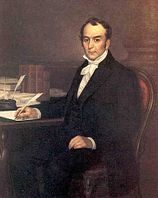United States House election, 1822
|
|
|||||||||||||||||||||||||
|---|---|---|---|---|---|---|---|---|---|---|---|---|---|---|---|---|---|---|---|---|---|---|---|---|---|
|
|||||||||||||||||||||||||
|
All 213 seats to the United States House of Representatives 107 seats were needed for a majority |
|||||||||||||||||||||||||
|
|||||||||||||||||||||||||
|
|||||||||||||||||||||||||
Philip Barbour
Democratic-Republican
Henry Clay
Democratic-Republican
Elections to the United States House of Representatives for the 18th Congress were held at different dates in each state between July 1, 1822 (in Louisiana) and August 14, 1823 (in North Carolina) during James Monroe's second term in office. This was the first election based on the results of the 1820 Census, which added a total of 26 seats to the House. Four states lost one Representative each, while nine states gained anywhere between 1 and 8 seats.
The campaign was waged between the Democratic-Republican Party and the Federalist Party. However, by this time, party unity had broken down and the consensus principles of the Era of Good Feelings were giving way to fragmentation. In turn, many historians classify the parties of the Representatives based on how they voted in the contingent election of 1825 (where the House determined the winner of the 1824 presidential election), at the end of the 18th Congress, with results similar to those in the following table. Michael J. Dubin classifies candidates based on the political parties supporting them in the elections of 1822-1823 (though he does not provide a nationwide tally).
This was the single largest gain by any President's party in House midterm elections in US history, and the only time the President's party made gains of 10 seats or more in such an election.
...
Wikipedia


